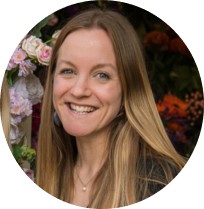Introducing Amy Hunter. A qualitative researcher, her natural conversational skills inspire participants to surface their thoughts and feelings. I caught up with Amy to explore her journey from market research to user research, via floristry.
Matt: Market research, floristry and now user research, how did it all start?
Amy: Event planning came first! I was fortunate to be a part of event planning for some well-known charities. My interest in qualitative research was born during my MSc in Marketing & Fundraising when I completed in-situ interviews with a range of Charity Directors as part of my dissertation.
My break into market research came soon after, part-luck, part pushing a door which led to a whole host of enjoyable and insightful experiences – along with a confirmed love of research. Once, I got to fly first class to Vegas, interviewing fellow travellers about their experience – a real highlight! Another was having the pleasure of introducing high-street retail brand Directors to customers within some of their key segments during a Customer Closeness Workshop. The CEO found their insights and perspectives so helpful that he invited a customer to meet up the following week to continue their conversation over coffee.
Floristry was my passion project. I had the joy of helping people to create something beautiful with their hands through floristry classes and prosecco usually helped!
Once I was even able to combine floristry with market research when I reviewed horticulture displays for a high-street brand. Then, long story short, a relocation to the south coast led me to user research and UX consultancy.
Matt: Market research vs user research, how do they compare and contrast?
Amy: Market research is wide and broad, you’re thinking about target markets, shopper base, demographics, emotions or favourite brands and identifying something that links an audience together and drives behaviour.
UX is more about a journey and about what a user is doing with a product or website at that time. We identify what people would typically, or naturally do. We encourage participants to continue contributing without interfering with their journey in any way. A nod every now and then is important, but not giving too many cues, so the participant doesn’t simply say more of what they think you want to hear.
Within market research, I would often be in-store completing on the spot depth interviews, intercepting people browsing a particular aisle or product. Sometimes, we’d meet with participants to complete assisted shopping trips to observe their behaviours. We would also run focus groups and arrange workshops to seek to understand and solve a particular problem through creativity and conversation.

To be honest, this can all fit within our research offering at Experience UX, it is all about understanding people. Market research is often looking at opinions and trends, whereas user research is observing people interact with products and services. But it all fits the wider picture of human behaviour.
I’ve already noticed that people have so many interpretations of what UX means. For me, it’s strictly observing the user and noticing the details. I’m a User Researcher, and that includes all forms of experience, whether that be user or customer experience. Users are customers and customers are users, it just depends on your frame of reference. Market research and user research cross over and complement each other; they simply need to be clear on the boundaries and context of their research.
Matt: Numbers vs words – what are you more drawn to?
Amy: I’m glad to have an understanding and experience of using numbers and stats through my time in market research, but my passion is in qualitative data. I’m naturally more drawn to conversations and identifying the ‘why’ behind the ‘what’.
A qualitative researcher needs to be able to go into a room with people they’ve never met before and encourage strangers to tell them things they may have never really thought about or considered – it requires personability and curiosity to listen, understand and encourage someone to open up.
Matt: I find that it’s a real privilege to see a window into peoples’ worlds during user research.
Amy: Yes, I totally agree – it’s fascinating. With remote researching, which everything is currently, you see where their sitting, you get a sense of what has happened during that day for them. You can build up a good picture into that person’s life from this digital window into their world.
A lot of user research is unseen and unheard, so not to bias anything. Our clients get so much from observing someone browsing and considering their product or service, they get to step out of the norm and see things in a different light.
Matt: Is there anything you’ve had to un-learn, do less of, or more of?
Amy: So much of floristry, market research and UX is being able to think on your feet and troubleshoot – you don’t know what you’ll be faced with every day, so you just get better at adapting to that. It’s good to not overthink things!
Matt: I’m picturing a Venn diagram of market research, user research and floristry. What’s in the middle?
Amy: People. Just people! It’s all about people.
Matt: Blooming people! Your passion for people shines through and through, and is what makes you so skilled in all you do. Thank you for sharing, Amy.

